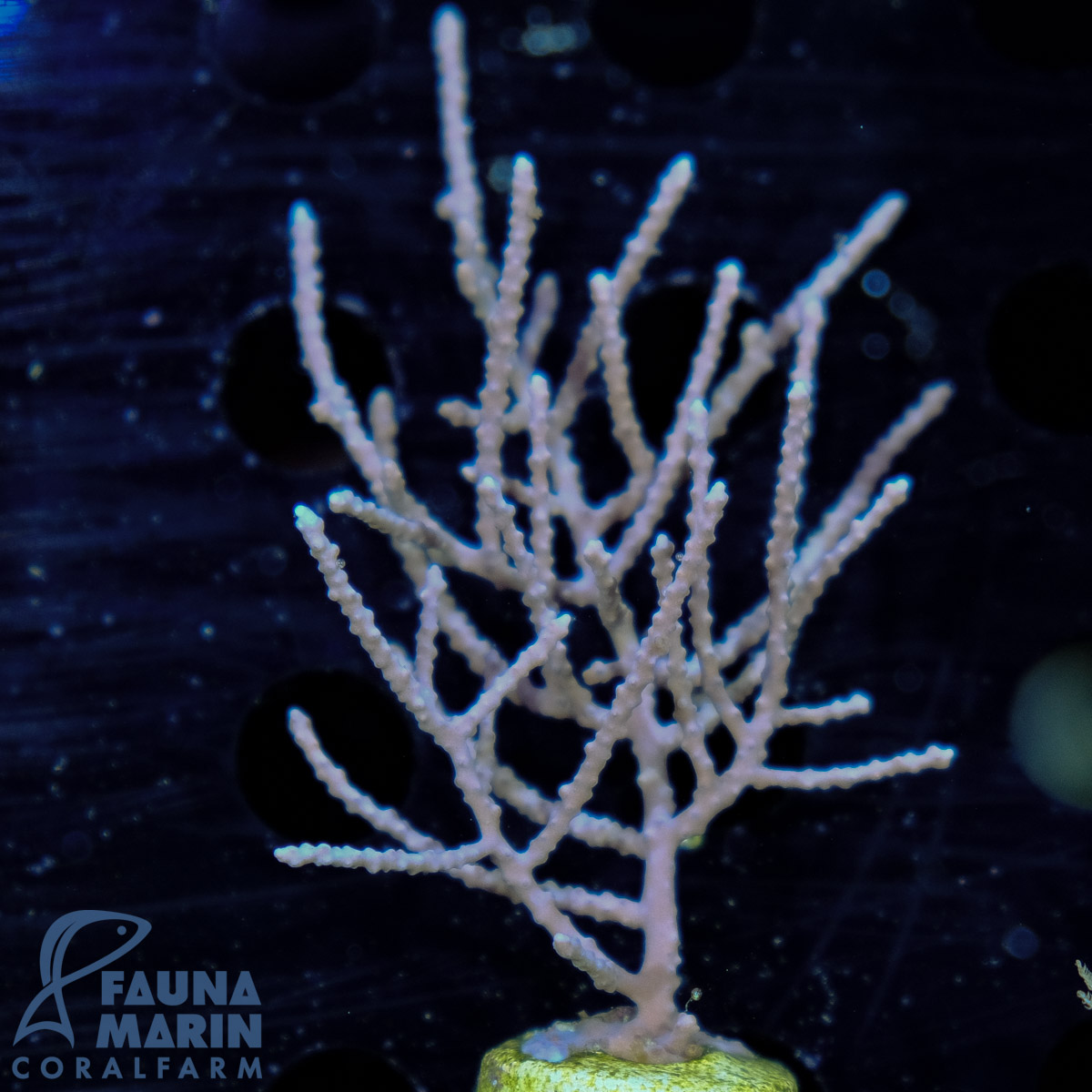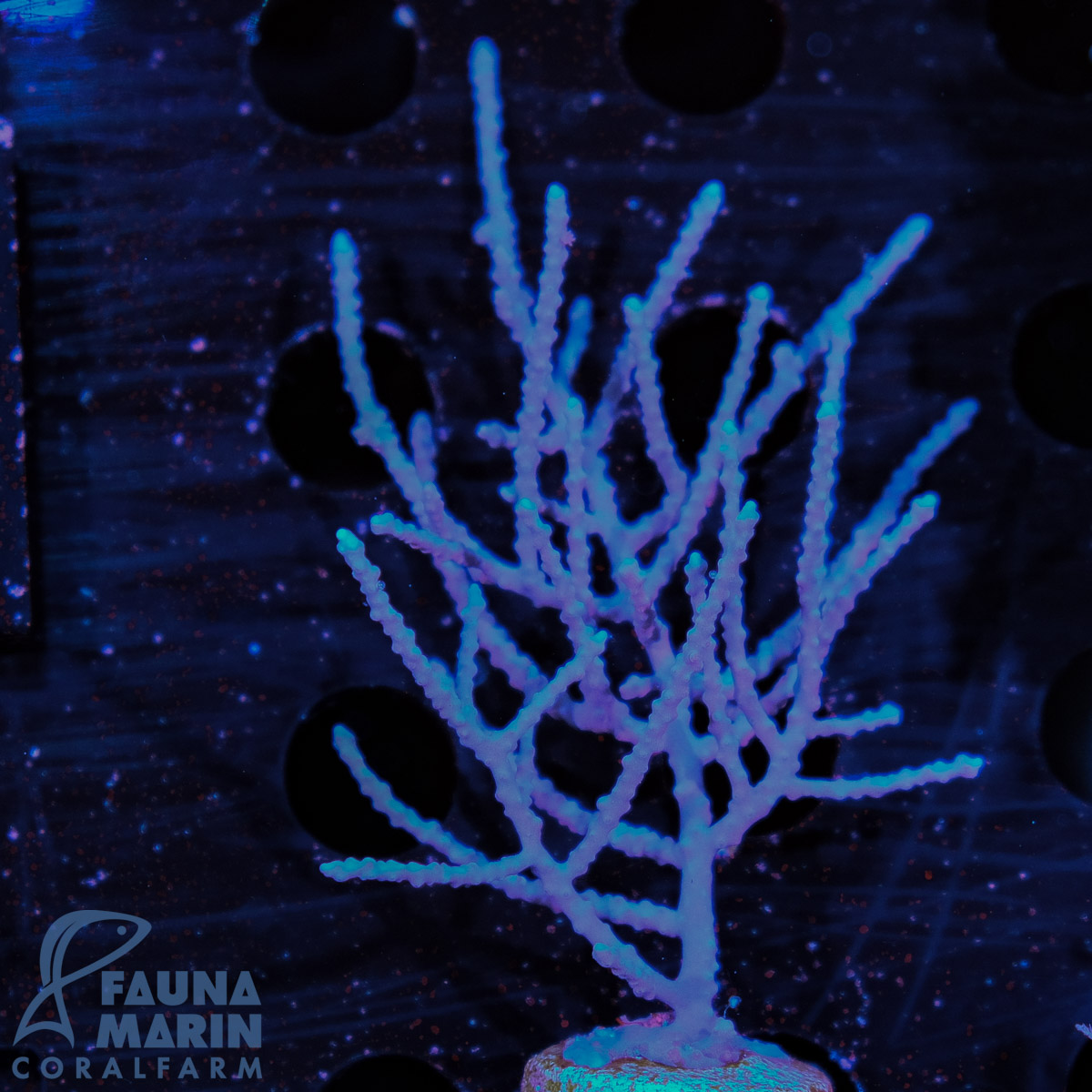FMC Pinnigorgia sp. Hornkoralle V
"FMC Coral Frags" Several branches from this coral are available. These animals differ only slightly in form. You will receive an offshoot similar to the animal depicted in the photo.
If you have any further questions, please check our Fauna Marin Support Forum and our Fauna Marin Reefing Group at Facebook. Useful tips + tricks about marine aquaristics are available on our Fauna Marin YouTube channel.
General information about Azoo/NPS corals:
NPS-Corals (= Non-Photosynthetic Corals) or Azoo corals do not have zooxanthellae and do not live on light. Thus, they can be placed in a dark location.
However, Azoo corals need to be fed regularly, then they are quite durable.
In addition, they like a laminar, light current that drives the food past them.
Feeding Tip:
For Azoo corals with large polyps, such as Tubastrea or Dendrophyllia:
Thawed frozen foods such as Mysis, or pellet and liquid foods such as Fauna Marin Ocean Plankton or Fish Plankton.
For Azoo corals with smaller polyps like gorgonians:
Liquid food, like the Fauna Marin Coral Plankton, as well as dust food like Coral Dust.
We recommend using the Fauna Marin ReefBuster or long tweezers to apply the food directly to the polyps. This is best done early in the morning or in the evening when the polyps are visible.
The keeping of NPS-corals is possible with today's technology, such as with the use of, for example, the Fauna Marin Balling Light method.
If you provide the right current, good lighting and the right water values, successful keeping with good growth and great colors is feasible in a marine aquarium.
In contrast to small poylp stony corals (SPS), which require rather lower nutrient values, the NPs-corals usually still cope well with higher nutrient values.
Nevertheless, like LPS and SPS corals, they require clean and clear water. To successfully maintain corals in the long term, stable water and nutrient levels should be aimed for.
This can be well controlled with various phosphate adsorbers. With filtration via activated carbon, such as Fauna Marin Carb L long-life carbon, the water remains crystal clear. Phenols, protein compounds, dyes and nettle toxins are filtered out of the water and rendered harmless.
Light intensity also affects the coloration and growth of the corals. At Fauna Marin Corals we successfully keep our corals under a mix of T5 tubes (50/50 white/blue), in combination with the LED lamps.
Important for the care of all corals is the constant maintenance of the salinity, as well as the use of a good sea salt, such as Fauna Marin Professional Sea Salt. The salinity should always be between 34/35 per mille, respectively 1.022 and 1.024 density.
A regular check of the density is an absolute must in marine aquaristics. Our salt calculator helps to calculate the correct amount of salt.
Pay attention - especially in summer - to the temperature in the aquarium. Corals do not tolerate temperatures exceeding 30 degrees for longer periods of time.
We recommend a regular control of the water values with our ICP water analysis.
Based on the results of the analysis, the water values can be adjusted correctly with the help of our dosage recommendations on our laboratory website.
***We will never ship freshly cut coral !***
We take great care to ensure the well being of all our corals. Before pieces are deemed saleable, we wait for every piece to have formed an encrusting edge and even develop baby polyps. As a professional supplier of quality frags in Germany, we differ significantly from our competitors. Our care and breeding practices for these wonderful corals make it possible to bring you the healthiest pieces available. The biggest difference, is in the regular feeding of the polyps; we feed LPS Grow and Color Food from Fauna Marin . All corals are prepared under optimum conditions to a healthy aquarium life and we consider this to be the optimum color formation under LED or blue T5 lighting.
***General Information:***
Due to the unknown variables that can happen during shipping, we cannot provide a 100% arrive alive guarantee for live animals , despite all efforts.
New orders begin processing the moment we receive them. Very rarely do we encounter a delay. If we do, and your corals or fish are not yet ready for dispatch, you have the option for a possible replacement animal or a refund for the amount of an animal. In such cases, you will be contacted via phone (if we have your phone number) or email. Of course, we do everything possible to avoid such inconvenience from the start.
Please note that coral variations in form and color can occur in the original photo. Changes in color may also result from transport or due to the color representation on the computer screen . Our corals are lit with Radions G4 Pro and are photographed in these conditions. The colors of the animals may vary from our photos when placed in your aquarium, depending on the type of lighting used.
All animals undergo a minimum one-week quarantine and are free of parasites when delivered.
Our average water parameters are:
Salinity : 34-35 psu
Calcium : 400-420 mg/l
Magnesium : 1200-1250 mg/l
dkH : 7.5-8.0
Nitrate : 2-15 mg/l
Phosphate : 0.02-0.08 mg/l
Temperature : 23-25 ° C
In our facilities, we use the new sea salt "
Professional Sea Salt
" by Fauna Marin . We also use the Balling light method in addition to their sea salt.
We are professional pet shippers with over 20 years of shipping and packing experience. All corals and other animals are carefully placed into their packing box and prepared with care. We take great care preparing corals and other animals for a safe transport so that they arrive to you in perfect condition. It is not primarily about the color of the animal upon arrival, it is about the health and nutritional status of coral and fish. The final coloration reach corals within a few weeks after being placed into your aquarium.


